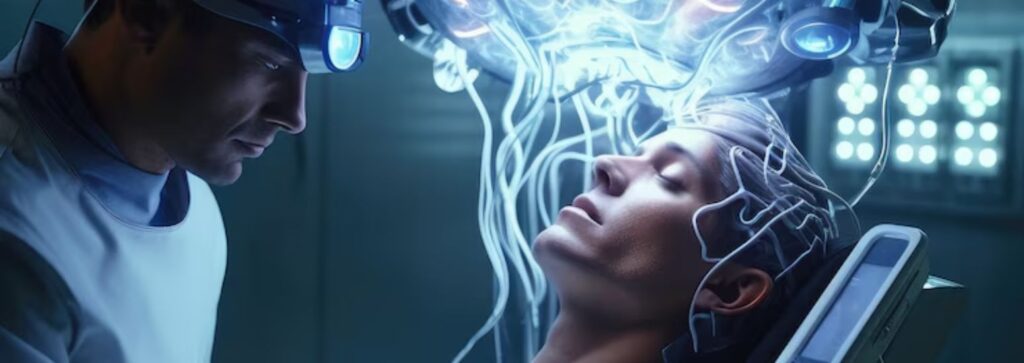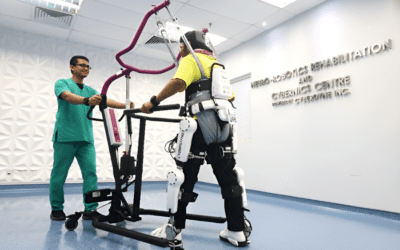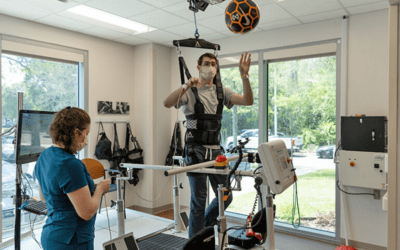Artificial Intelligence is already a part of our lives. AI seems to be intertwined with everything we do these days. This is certainly true for healthcare.
Artificial intelligence (AI) is the simulation of human intelligence by machines. Machine learning (ML) is the process by which a computer algorithm perceives data, identifies patterns, and finally predicts relationships within those patterns.
AI has great potential for motor recovery within the field of rehabilitation medicine. These technologies can aid in assessing patients’ conditions, designing personalised treatment plans, monitoring progress, and optimising rehabilitation strategies.
Role of AI in personalised rehab

AI uses patient data to tailor rehabilitation regimens and continuously adapt therapies based on real-time progress monitoring. It will analyse a patient’s medical history, physical condition, and progress information to create personalised rehabilitation plans customised to their unique needs and abilities.
Understanding AI in Physical Therapy
- AI has expanded its role in physical therapy, intending to provide better and more efficient care.
- AI gives machines the ability to think and learn, a bit like how humans do, but instead of brains, they use algorithms and data.
- The key components that allow AI to think and learn include machine learning, data analysis, and neural networks.
- Think of Machine learning as the engine of AI. It helps to make decisions based on the patient’s data and can provide immediate care solutions.
- Neural networks are like the brains of AI systems. They consist of layers of interconnected nodes to help AI make sense of complex data.
- AI technologies have been integrated into physical therapy to help with the automation of clinical tasks. It uses technologies such as motion analysis, wearable devices, and virtual therapists to assist the physical therapy practise in patient care.
- AI can analyse how patients move and pinpoint problems in their movements through motion analysis.
Another AI-powered technology that physical therapists can utilise is virtual therapy (telerehabilitation). Virtual therapists can help answer basic questions that don’t warrant an actual visit while also assisting during out-of-office hours to provide guidance and support. All of these technologies make physical therapy more accessible to patients.
Transforming Rehabilitation with AI

- AI is transforming rehabilitation with personalised treatment plans, virtual/augmented reality, and telerehabilitation. AI will use patient data to tailor rehabilitation regimens and continuously adapt therapies based on real-time progress monitoring. It will analyse a patient’s medical history, physical condition, and progress information to create personalised rehabilitation plans customised to their unique needs and abilities.
- New immersive AI technologies like virtual reality (VR) and augmented reality (AR) are used to create engaging and interactive rehabilitation environments.
- It has been shown to help stroke survivors improve limb function and recover faster by simulating scenarios for cognitive and physical exercises.
- AI also enables remote rehabilitation through telemedicine. Patients can receive therapy sessions and guidance from video calls and AI-powered exercises from the comfort of their homes while allowing for practitioner monitoring remotely.
- Telae-rehabilitation through AI can help increase access to patients for long-term rehabilitative care. VR-based interventions can provide more compliance and keep patients engaged longer, improving their health outcomes.
Enhancing Injury Prevention Through AI

- Machine Learning and analytics have made it so that AI can enhance injury prevention. With ML, some algorithms use predictive analytics of the biomechanical data of patients to identify vulnerabilities.
- The tools can use risk prediction as an early intervention strategy and help Physical trainers create and monitor rehabilitation for their patients.
- Preventing injuries has been made more efficient by combining wearable devices with AI-powered monitoring. These devices integrate sensors to track movement, posture, and muscle activity.
- The real-time feedback from the monitoring devices helps prevent overexertion and ensures that people are using the correct form. With this new technology, therapists can monitor their patient’s recovery process and compliance through direct visual and audio feedback of the assigned exercises.
- AI will compute the data to provide insights on optimising training plans.
- The use of AI in healthcare allows for a personalised rehabilitation that’s based on long-term monitoring.
Conclusion:
AI technologies are already integrated into our healthcare systems and will continue to grow in this field. AI is used for the automation of clinical tasks, patient monitoring, remote rehabilitation, injury prevention, personalised treatment regimens, and many other clinical applications. These tools improve patient treatment compliance and expand care access.
These implications indicate the need for continued research, more education, and additional legal considerations to adequately incorporate AI use so that patients and practitioners reap the benefits while reducing the negative unintended consequences.



